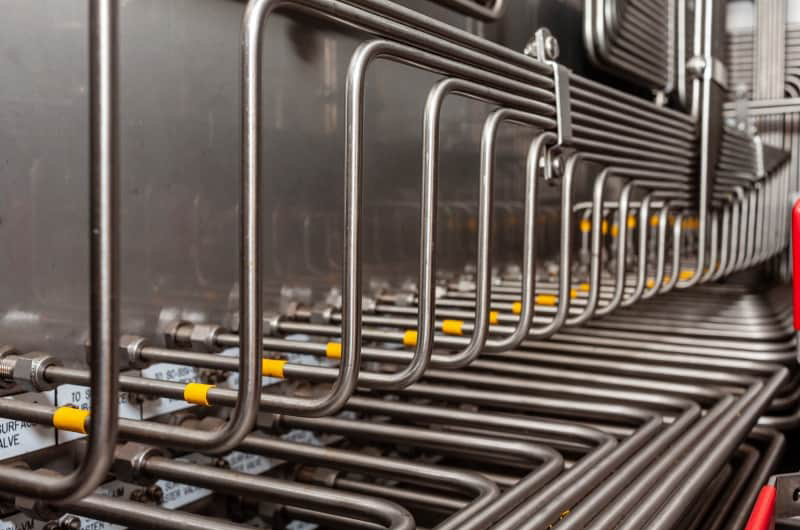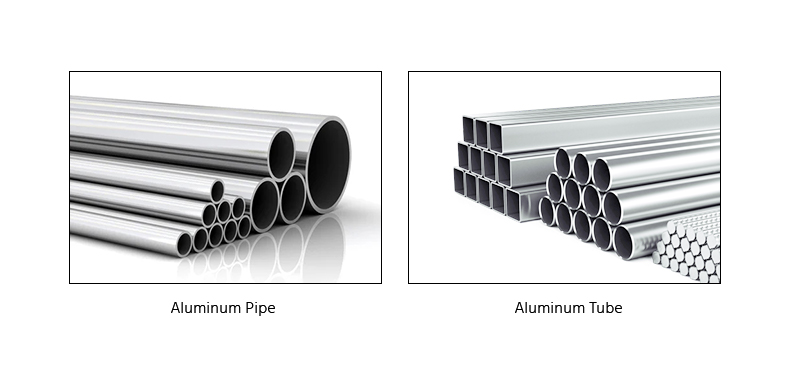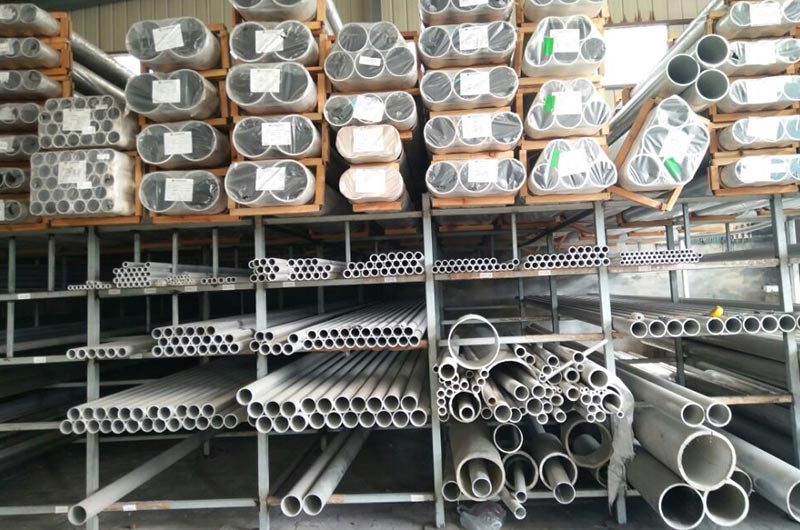Pipe and Tube may be two terms for hollow cylinders, but they are not the same. In some cases, the two terms can be used interchangeably. However, there are some differences between aluminum pipe and tube, especially in the ordering method and tolerance of materials.
We will help you to understand the differences between pipe and tube in detail from shape, size, application and other aspects. If you still have some questions, you can consult Aiboer. With our rich production and sales experience and complete product inventory, we can solve all problems related to pipe and tube for you.

The definition of aluminum pipe and aluminum tube
Aluminum pipe
Aluminum pipes are classified as tubular vessels used in pipelines and piping systems, which are usually used to transport gases and fluids. They are specified by the Nominal Pipe Size (NPS) and Schedule (Wall Thickness).
Generally, pipe refers to a hollow cylinder made of metal or other materials used to transport water, gas, steam, oil, etc.

Aluminum tube
Aluminum tubes are usually used in structural engineering, and the outer diameter is an important and accurate figure. OD and WT (wall thickness) specify the pipe size. Aluminum tubes have many characteristics, such as the weight is light and it is more easily to accept paint and other decorations.
In general, tube is a hollow aluminum cylinder, especially used to transport or contain liquid or gas.

The difference between aluminum pipe and tube
| Aluminum Pipe | Aluminum Tube | |
| Shape | circle | circle, rectangle, square, oval |
| Key dimensions | The most important dimensions are outer diameter (OD) and wall thickness (WT). OD-2×WT (SCHEDULE) determines the inner diameter (ID) of the pipe, which is the liquid capacity of the pipe. | The most important dimensions are outer diameter (OD) and wall thickness (WT). These parameters, expressed in inches or millimeters, represent the true dimension value of the hollow section. |
| Wall thickness | The thickness of aluminum tubes is specified by the "Schedule" value (the most common ones are Sch. 40, Sch. STD, Sch. XS, and Sch. XXS). Two pipes of different NPSs with the same schedule have different wall thicknesses (In inches or millimeters). | The thickness of aluminum tubes is specified by the "Schedule" value (the most common ones are Sch. 40, Sch. STD, Sch. XS, and Sch. XXS). Two pipes of different NPS and the same specification have different wall thicknesses (in inches or millimeters). |
| Measure | Measured by nominal outside diameter (also known as NPS or nominal pipe size) and wall thickness. | It is measured by accurate outer diameter (OD) and wall thickness. Generally with more stringent tolerances and specifications. |
| Scalability | Tube can be scaled. | |
| Rigidity | Pipe is rigid and cannot be formed without special equipment. | It can be shaped through some efforts. The tubing will not be excessively deformed, wrinkled or broken when bent and coiled. |
| Strength | Pipe is less powerful than tube. | Stronger for applications requiring durability and strength. |
| Processing method | Hot rolled only. | Cold rolled and hot rolled. |
| Application | Pipe is the rated pressure used to transport fluid or gas pipe is suitable for larger applications. | Tube is used for structural applications. Usually used where small diameters are required. |
Difference in shape, size and structure between aluminum pipe and tube
Pipe is always round. It cannot be formed easily without using special equipment. Pipes are usually seamless and pressure rated to avoid leakage, as they usually carry liquids or gases. The size of the pipe is usually larger than the pipe. Pipes are suitable for larger applications ranging in size from half an inch to a few feet.
Tube can be rectangular, square, or circular. They are usually seam welded. Tubes are typically used for applications requiring smaller diameters.

Difference in diameter between aluminum pipe and tube
Pipe is only provided with an inside diameter and a "schedule" which means wall thickness. There's an easy way to remember this – since pipe is used to transfer fluids or gas, the size of the opening through which the fluids or gas can pass through is probably more important to you than the outer dimensions of the pipe. The tolerance for pipes is looser than tubes. Pipes are usually used for transporting or distributing, therefore the properties of pressure, straightness, or roundness are strictly specified.
Tube is usually measured by the outside diameter dimension – or OD with a set range of wall thickness. The wall thickness is vital as the tube's strength is dependent on it. One might think that a 3.0 inch OD tube would measure 3.0 inches and a 7.5 inch OD tube would measure 7.5 inches. However, machines today cannot hold dimensions precisely to the nominal value, and because of that, there must be acceptable degrees of variations. In other words, every dimension on a blueprint is subject to variations from the nominal value.

Difference in wall thickness between aluminum pipe and tube
Wall thickness of pipe (mm, inch or gauges). Gauge measures (BWG or SWG) are used for thinner wall thicknesses, whereas larger measures are expressed with fractional or inch indexes. The wall thickness of a pipe is referred to as a pipe schedule thickness. The most common pipe schedules are SCH20, SCH40, and SCH80.
The thickness of tube is often specified by a gauge for thinner thickness and for thicker tubing. It is indicated by fractions of an inch or millimeter. The normal range of tubing is 20 gauge, which is 0.035 inches up to a thickness of 2 inches.
Difference in surface treatment between aluminum pipe and tube
Pipes need to be painted or coated to anti-corrosion or oxidation for outdoor field transporting or underground transporting.
Tube often goes through sour cleaning or special polish treatment for their particular field uses.
Difference in end finishes and connection between aluminum pipe and tube
Pipe ends are usually in a plain, beveled or threaded and coupling form. Connecting one pipe to another is much more of a labor intensive process as it requires welding, flanges, or threading. Pipe welding is safer than tube joining.
Tube generally comes with coupling ends or special end finishes like irregular ends, special screw thread, etc. Tube can be joined quickly and effortlessly with flaring, coupling, or brazing. Tubing assemblies can also take place through tube fittings where high standards of construction are needed.
Difference in order and cost between aluminum pipe and tube
Pipe is usually used to transport gas or liquid, so capacity is very important. Knowing how much can flow through the pipe is key. The circular shape of the pipe makes it more efficient in handling the pressure flowing through the liquid.
Therefore, pipe is usually ordered by using the nominal pipe size (NPS) standard and specifying the nominal diameter (pipe size) and schedule number (wall thickness). The schedule numbers on pipes of different sizes can be the same, but the actual wall thickness will be different.
Tube is used for structural applications, so the outer diameter becomes an important dimension. Tube is typically used in applications where an accurate outside diameter is required, as it will indicate how much it can accommodate as a stabilizing factor. The strength of the pipe depends on the wall thickness, which is defined by the specification number. A smaller specification number indicates a larger outside diameter. The inside diameter (ID) is the theoretical value.
Therefore, tube is usually ordered by outer diameter and wall thickness. However, it can also be ordered as an OD and ID or ID and wall thickness. Although the pipe has three dimensions (outer diameter, inner diameter and wall thickness), only two can specify tolerances, and the third is theoretical. Usually order pipes and maintain tighter and more stringent tolerances and specifications than pipes.
The manufacturing process of pipe is easier and it is generally mass production. So, the price of pipe is relatively low. And tube needs a higher level of process, testing and inspection. Therefore, the delivery time is longer and the output is much lower than pipe. So, the price of tube is slightly higher.
Aiboer - professional manufacturer and supplier for aluminum pipe and tube
We have a large amount of aluminum tube products for any project you need. We are very proud that we are ready to help you meet your aluminum tube needs with our exquisite production technology and full model inventory. If you have any questions or needs about aluminum pipes and tubes, please contact us immediately for more information and obtain detailed product specifications, quotations and samples.

Tip: 10 points for ordering pipe and tube
- Which alloy?
- Which temper or hardness?
- Welded, welded and drawn, or seamless?
- What specifications do you need to meet?
- What cross-sectional dimensions?
- How long?
- What surface finish?
- How straight?
- Do you need ovality, concentricity or eccentricity?
- How clean does it need to be?